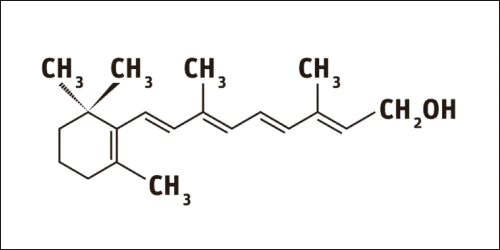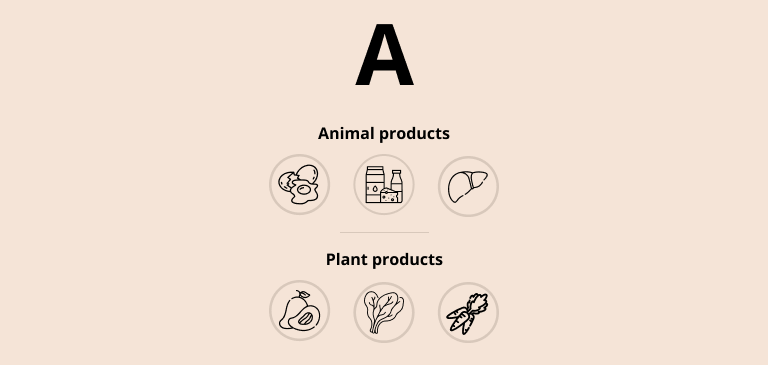Vitamin A
Retinol | Carotenoids
Year of discovery: 1913 | Elmer McCollum and Marguerite Davis
Vitamin A plays a key role in the visual system, skin, genes, normal growth and immune system. It is especially important in the early stages of pregnancy and supports embryonic development. The need for vitamin A increases with the onset of infections and fevers. In the body, vitamin A acts in three different forms: retinol, retinal and retinoic acid. These are known as retinoids. The body's cells can convert retinol and retinal into other active forms of vitamin A as needed. Each form of vitamin A has specific functions. Retinol aids reproduction and is the main transport form of the vitamin. Retinal is active in the visual system, and is also an intermediate during the conversion of retinol to retinoic acid. Retinoic acid acts as a hormone that regulates cell division, growth and development. Foods of animal origin are a source of retinol in a form that is easily digested and absorbed. Foods of plant origin are sources of carotenoids, some of which act as vitamin A. The body can convert carotenoids such as β-carotene, α-carotene and β-cryptoxanthin into vitamin A. Conversion ratios from carotene sources in food to vitamin A are 12:1 for β-carotene and 24:1 for β-cryptoxanthin
Major sources of vitamin A
Retinol is found in liver, egg yolk, butter, non-skimmed milk and cheese. Carotenoids are found in orange-fleshed sweet potatoes, orange-fleshed fruits (e.g., melons, mangoes and ebony trees), green leafy vegetables (e.g., spinach, broccoli), carrots, pumpkin and red palm oil.
Bioavailability of vitamin A
The bioavailability of vitamin A from animal sources is high - the body absorbs about 70-90% of ingested vitamin A. Carotenoids from plant sources are absorbed at a much lower level - between 9% and 22% - and the proportion that is absorbed decreases as more carotenoids are consumed. Fats in food increase vitamin A absorption. The food palette affects β-carotene absorption. β-Carotene from dietary supplements is more easily absorbed than β-carotene from food. Cooking carrots and spinach also increases β-carotene absorption. Diarrhea or parasitic infections in the intestines are associated with malabsorption of vitamin A.
Risks of insufficient or excessive intake of vitamin A
The liver stores about 90% of vitamin A. Vegetarians can meet their vitamin A needs through sufficient intake of deeply colored fruits and vegetables, through fortified foods, or from both. Vitamin A deficiency is a serious problem when the diet consists of starchy staple foods that do not provide a good source of retinol or β-carotene, and when the intake of deeply colored fruits and vegetables, foods of animal origin or fortified foods is low. Vitamin A plays a key role in transporting iron from resources in the liver, so vitamin A deficiency can also affect iron levels. High intake of vitamin A in its finished form can cause high levels of the vitamin in the liver - a condition known as hypervitaminosis A. No such risk has been observed with high intake of β-carotene.




